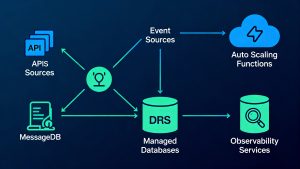Java developers have developed modern web applications and services using Spring Framework and Spring Boot for years. Spring, being a lightweight framework provides a lot of support for developing robust, scalable, and maintainable Java-based applications. It’s often used in enterprise environments where performance, scalability, and manageability are critical, while Spring Boot is a Java-based framework that is best for creating stand-alone, Spring-based applications in a short period.
Though both play a crucial part in the Spring ecosystem, their usage varies, and each fills a different hole in the part of the application under development.
As we discuss Spring usage and its importance for developers in modern software developments, we would need to address the key differences between Spring Framework and Spring Boot.
Difference Between Spring and Spring Boot
While Spring Framework and Spring Boot both belong to the same ecosystem, they serve different purposes and have key differences. Here’s a breakdown of those differences:
| Aspect | Spring Framework | Spring Boot |
| Configuration | Requires manual configuration for most features (e.g., XML files, annotations). | Automatically configures applications based on dependencies. |
| Setup Complexity | High setup complexity, and needs additional configuration files. | Simplified setup with minimal configuration and pre-configured defaults. |
| Application Structure | Traditional approach with separate configuration files, components, and annotations. | Convention over configuration approach with minimal boilerplate code. |
| Embedded Server | Requires external server deployment (e.g., Tomcat, WebLogic). | Supports embedded web servers like Tomcat, Jetty, and Undertow. |
| Learning Curve | Steeper learning curve due to its extensive features and configurations. | Easier learning curve with simpler setups and fewer configuration requirements. |
| Project Type | Suitable for large, complex enterprise applications. | Ideal for microservices, standalone apps, and quick development. |
| Development Speed | Slower, as it requires more time for configuration and setup. | Faster, as it includes pre-configured templates and dependencies. |
| Customization | Highly customizable for complex use cases. | Focuses on rapid development with less customization. |
| Deployment | Needs separate deployment of the application and server. | Can be deployed as a single executable JAR or WAR file. |
What is Spring Framework?
Spring Framework is an open-source framework that makes building Java applications easy by providing lots of infrastructure support in developing robust Java-based applications. Its first version was written by Rod Johnson in 2003 and currently, Spring Framework 6.0 is available and supports modules for most concerns, such as:
- Inversion of Control (IoC): This is the central feature of Spring, which enhances decoupling between components. The Spring container offers a uniform way of configuring applications and integrates well with almost all Java environments, from small applications to large enterprise applications.
Types of IoC
- Dependency injection (DI): Allow developers to manage components of applications and their dependencies with much easier approaches that promote loose coupling and make the code easier to test and maintain.
- Dependency Lookup: This is the pattern where the container object will ask the caller to provide a required object whose name or type matches the provided details. A programmer never directly creates the object but lets the Spring application configure how such an object could be created; the programmer creates a definition within the Spring configuration file.
- Aspect-oriented programming (AOP): The Spring Framework has an Aspect-oriented programming (AOP) framework that modularizes cross-cutting concerns in aspects.61 The motivation for creating a separate AOP framework is to provide basic AOP features without too much complexity in design, implementation, and configuration.
The Spring AOP framework makes full use of the Spring container and provides a mechanism for the separation of crosscutting concerns like logging, security, and transactions.
Since version 2.0 of the framework, Spring provides two approaches to the AOP configuration:
- schema-based approach
- @AspectJ-based annotation style
- Data Access framework: The data access framework addresses common difficulties that developers face, Including support for JDBC, Hibernate ORM frameworks, and transaction management.
For all of these supported frameworks, Spring provides these features
- Resource management – automatically acquiring and releasing database resources
- Exception handling – mapping data access related exception to a Spring data access hierarchy
- Transaction involvement – open involvement in current transactions
- Resource unwrapping – retrieving database objects from connection pool wrappers
- Abstraction for binary large object (BLOB) and character large object (CLOB) handling
- Model-View-Controller: Spring MVC is request-based web framework that simplifies the development of web application. By offering a cleaner front end code it provides separation of concerns between layers like controllers, views, and models.
Most significant interfaces in Spring MVC, with their roles:
- Controller: Controls incoming requests and directs them to proper responses. It determines whether the information goes to the Model or the View.
- HandlerAdapter: This adapter will execute objects handling incoming requests.
- HandlerInterceptor: responsible for catching incoming requests. Comparable, yet not equal to Servlet filters (use is optional and not controlled by DispatcherServlet).
- HandlerMapping: responsible for choosing objects that handle incoming requests (handlers) based on any attribute or condition internal or external to those requests
- LocaleResolver: responsible for resolving and optionally saving the locale of an individual user.
- MultipartResolver: Facilitates work with file uploads by wrapping incoming requests.
- View: responsible for returning a response to the client. The View should not contain any business logic and should only present the data encapsulated by the Model. Some requests may go straight to View without going to the Model part; others may go through all three.
- ViewResolver: responsible for selecting a View based on a logical name for the View. (use is not strictly required)
- Model: It encapsulates business data. The controller exposes the model to the view. (use is not strictly required).
- Security: This provides the capability of authentication and authorization for any enterprise-level applications. The spring framework allows the development of flexible and adaptable applications. Also, it requires some huge configuration for basic tasks only. Support is available for jobs with batch process and scheduling.
Spring Use Cases:
Springs framework is meant to be used for various applications. This includes:
- Development of serverless applications
- Development of scalable microservices
- Server-side security of your application
- Asynchronous development of applications
- Automation by developing batches
Disadvantages of Spring Framework
- Complexity: Difficult to learn if you don’t have a lot of development experience.
- Parallel Mechanism: Developers enjoy a variety of options and make it difficult to decide which features to use and which to avoid.
- No Specific Guidelines: Spring framework is unconcerned with XSS or cross-site scripting.
- XML: Creating a Spring application necessitates a large amount of XML.
What is Spring Boot?
Spring Boot is an extension of the Spring Framework that makes setting up and developing Spring applications easy. By providing a pre-configured platform for building Spring-powered applications with minimal XML and annotation-based configuration. It Streamlines application development by removing boilerplate configuration and many out-of-the-box defaults in Spring-based setups.
Here are some key Features of Spring Boot
- Auto-Configuration: Automatically configures an application based on project dependencies, so the manual configuration becomes negligible.
- Embedded Servers: Supports embedded web servers (like Tomcat and Jetty), through which you may execute applications as standalone executables.
- Production-Ready Features: Health checks, metrics, and extensible externalized configuration are just some of the features that can be included in applications once they reach production.
- Minimal Setup: Complex XML-based configurations do not have to be set up; one can instead use Java-based configuration.
- Spring Boot CLI: It is a command-line interface through which you can quickly run and test Spring Boot applications.
Use cases for Spring Boot
Spring Framework gives incredible freedom and power in the building of Java applications; however, setup and configuration do take up more time. This is where Spring Boot becomes valuable.
Rapid Development: Spring Boot eliminates much of the boilerplate code required for setting up a Spring application. With auto-configuration and built-in tools, it accelerates the development process.
Microservices Architecture: Spring Boot’s focus on minimal configuration and its ability to run as standalone applications make it ideal for building microservices.
Embedded Servers: There is no longer a requirement for managing separate web server setups. Applications with Spring Boot are capable of being executed as self-contained executable JARs which reduces deployment complexities.
Production-Ready Features: It comes with built-in features like health checks, monitoring, and metrics, making Spring Boot a production environment application development tool. Thus, the process of deployment and maintenance becomes less cumbersome.
Spring Boot simply eliminates the complexity associated with traditional Spring development. Thus, the application development process can be easily followed by the developers, testing and deploying applications within a short time frame.
Disadvantages of Spring boot
- Lack of control: Due to a high number of unused dependencies, hence gives a very big deployment file.
- Complex process: The complex and time-consuming process of migrating a legacy or already existing Spring project to become a Spring Boot application.
- Limited suitability: Though Spring Boot is great for use in microservices, many developers consider it not fit for use in large applications.
Conclusion
Both are integral components of the contemporary Java ecosystem, though they serve different purposes. When it comes to large-scale applications, one can state that the Spring Framework is a versatile, flexible, highly configurable, and very robust platform.
The concepts of Spring Framework are simplified in Spring Boot, which makes it suitable for microservices, standalone applications, and rapid development. Where Spring Boot is not a substitute for the Spring Framework, it reduces the setup and configuration overhead to greater extents, making it preferable today in modern Java developments.
Developers can opt for either Spring or Spring Boot according to the needs of the project—whether it is for customization and flexibility, or better to go with speed and simplicity. Spring Boot is ideal for quick setup with the least amount of configuration. If you’re looking for a more customized approach to your application’s configuration and architecture, you can use the Spring Framework.



